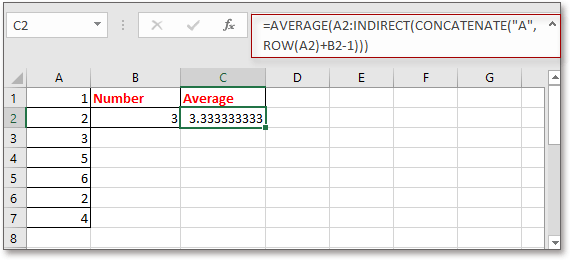¿Cómo definir un rango basado en el valor de otra celda en Excel?
Calcular un rango de valores es fácil para la mayoría de los usuarios de Excel, pero ¿alguna vez has intentado calcular un rango de valores basado en el número de una celda específica? Por ejemplo, hay una columna de valores en la columna A, y quiero calcular el número de valores en la columna A basándome en el valor en B2, lo que significa que si hay un 4 en B2, promediaré los primeros 4 valores en la columna A como se muestra en la siguiente captura de pantalla. Ahora presento una fórmula simple para definir rápidamente un rango basado en el valor de otra celda en Excel.
Definir rango basado en el valor de la celda
 Definir rango basado en el valor de la celda
Definir rango basado en el valor de la celda
Para realizar un cálculo para un rango basado en el valor de otra celda, puedes usar una fórmula simple.
Selecciona una celda en blanco donde colocarás el resultado, introduce esta fórmula =PROMEDIO(A1:INDIRECTO(CONCATENAR("A",B2))), y presiona Enter para obtener el resultado.
1. En la fórmula, A1 es la primera celda en la columna que deseas calcular, A es la columna sobre la que calculas, B2 es la celda en la que te basas para calcular. Puedes cambiar estas referencias según sea necesario.
2. Si quieres hacer un resumen, puedes usar esta fórmula =SUMA(A1:INDIRECTO(CONCATENAR("A",B2))).
3. Si el primer dato que deseas definir no está en la primera fila en Excel, por ejemplo, en la celda A2, puedes usar la fórmula de esta manera: =PROMEDIO(A2:INDIRECTO(CONCATENAR("A",FILA(A2)+B2-1))).
Contar/Sumar rápidamente celdas por color de fondo o formato en Excel |
En algunos casos, puede que tengas un rango de celdas con múltiples colores y lo que quieres es contar/sumar valores basados en el mismo color, ¿cómo puedes calcularlo rápidamente? Con Kutools para Excel's Contar por Color, puedes realizar rápidamente muchos cálculos por color y también generar un informe del resultado calculado. ¡Descarga Kutools y pruébalo hoy! |
Kutools para Excel - Potencia Excel con más de 300 herramientas esenciales. ¡Disfruta de funciones de IA gratis permanentemente! Consíguelo ahora |
Las mejores herramientas de productividad para Office
Mejora tu dominio de Excel con Kutools para Excel y experimenta una eficiencia sin precedentes. Kutools para Excel ofrece más de300 funciones avanzadas para aumentar la productividad y ahorrar tiempo. Haz clic aquí para obtener la función que más necesitas...
Office Tab incorpora la interfaz de pestañas en Office y facilita mucho tu trabajo
- Habilita la edición y lectura con pestañas en Word, Excel, PowerPoint, Publisher, Access, Visio y Project.
- Abre y crea varios documentos en nuevas pestañas de la misma ventana, en lugar de hacerlo en ventanas separadas.
- ¡Aumenta tu productividad en un50% y reduce cientos de clics de ratón cada día!
Todos los complementos de Kutools. Un solo instalador
El paquete Kutools for Office agrupa complementos para Excel, Word, Outlook y PowerPoint junto con Office Tab Pro, ideal para equipos que trabajan en varias aplicaciones de Office.
- Suite todo en uno: complementos para Excel, Word, Outlook y PowerPoint + Office Tab Pro
- Un solo instalador, una licencia: configuración en minutos (compatible con MSI)
- Mejor juntos: productividad optimizada en todas las aplicaciones de Office
- Prueba completa de30 días: sin registro ni tarjeta de crédito
- La mejor relación calidad-precio: ahorra en comparación con la compra individual de complementos